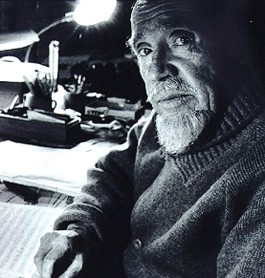The first record I listened to in the year 2011, upon waking up after a long night of being around food, dancing, drugs, music, drinks, bike rides in the rain, crowded kitchens, hugs from friends, kisses from loved ones, Champagne toasts, Carson Daly’s terrible jokes, too many texts, unsafe drives and staying up until 4:30am, was Conlon Nancarrow’s Studies for Player Piano.
A terrible choice, by most accounts. My usual tradition is to listen to something calming on New Year’s morning, like Belle & Sebastian’s If You’re Feeling Sinister. Something familiar from my teenage years, like the Fastbacks, or something longstanding and reassuring, like John Fahey. Nat King Cole. Dylan’s acoustic albums, perhaps, or the Band’s Music from Big Pink. Anything to flush the chaos of the year away, like the rising waters in the creek near my house that sweep all the moss and mud and sediment downstream.
But the hell with it. It’s 2011. Conlon Nancarrow’s music is disjointed, sketchy and coming from too many directions at once. It’s the soundtrack to the coming year, with its incessant distractions. Ten years ago, we weren’t updating our statuses every hour. Our lives weren’t consistently interrupted by calls from our pants pocket. We didn’t have to know about the meme of the hour before it grew stale or the news of the world right as it was happening. We were able to exist in the moment, and to enjoy it, rather than record it.
As many of his devout followers have found—from Pat Metheny and Jason Moran to the Kronos Quartet and Thurston Moore—listening to Nancarrow isn’t existing in the moment. It’s being pricked all over one’s body by needlepoint pins wielded by dehydrated iguanas thousands of times every minute, over and over. Kind of like modern life.
Born in 1912 into the age of the player piano, Nancarrow was a communist, a composer, a political activist and, eventually, an expatriate to Mexico City, where he died in 1997. His approach to music making was decidedly backward. Whereas pianists of his day created piano rolls with a mechanism that recorded their real-time playing and punched holes across a paper roll as the keys were struck, Nancarrow went straight for the paper roll with an X-Acto knife and a boundless imagination. This allowed him to prepare piano rolls of ridiculously crowded music, with fast, wild playing impossible to recreate by human hands. Why he chose such disastrously schizophrenic music to make is clear to anyone who listens to it, or attempts to listen to it: he did it because he could. It’s the sound of possibility magnified.
Likewise, we do things now not because we need to but simply because we can. We live in the age of the gizmo. We use GPS systems when we know the way already. We ask our phones questions even though we could ask a human being. We exercise with a controller in our hand and a dongle on the television when the world is right outside our door for the jogging.
As for making music—where to start? Every single vocal track is manipulated, every drum and guitar and keyboard processed by plug-ins and effects. This past decade has seen a revolution in recording, where manipulation isn’t a postproduction convenience but rather the starting point of a track. The quickest glance at the activity on a computer screen in a recording studio during editing these days would blow the average person’s mind.
It’s an approach to making music backward, just like Nancarrow did 60 years ago. If art imitates life, that means we’re largely living backward, too. As I write this, the house is a mess. I have seven tabs open in Firefox. The television is on. My wife’s iPhone is alerting away. My head hurts. Nancarrow is banging away from the speakers, prattling incessantly, like a class of school kids jumping on the piano keys.
And I’ll tell you. As soon as this record is over, I’m going out to Armstrong Woods State Park, taking a hike through the centuries-old redwood trees and breathing some fresh, calm air. If I’m lucky, or if I’m not too distracted, I might even come home and throw on Music from Big Pink.











